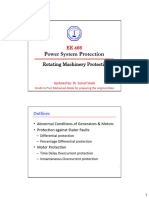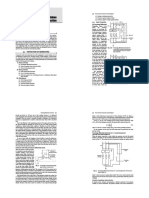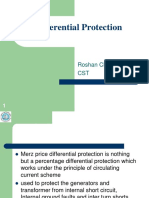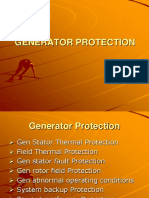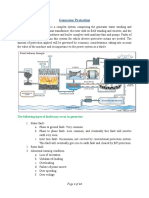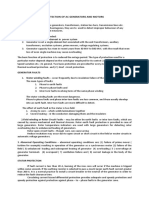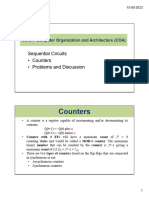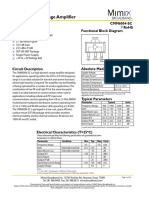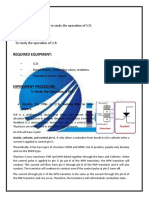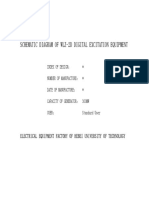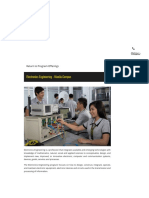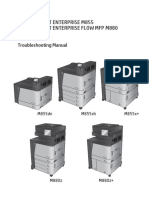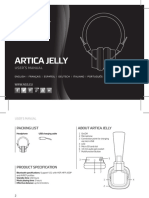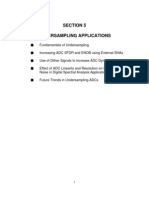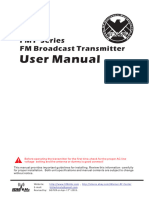e m Pr o te c t i o n
Po w e r S y s t
C h a p t e r ( 2 )
Lecture (3)
r P r o t e c t i o n
Gen e r a t o
P r o f. B is h o y E . S edhom
Assoc.
E le c tr ic a l E n g in eering
Depar tment Of
in g – M a n s o u r a Univer sity
e r
Faculty Of Engine
�Complexities of generator protection
2
2
�❑ The electrical ratings extend from a few hundred kVA (or even less) for reciprocating engine and
renewable energy sets, up to steam turbine sets exceeding 1200MVA.
❑ Faults of many kinds can occur within this system for which diverse forms of electrical and
mechanical protection are required.
❑ The amount of protection applied will be governed by economic considerations, taking into
account the value of the machine, and the value of its output to the plant owner.
3
3
�❑ The generator protection is very complex compared to protection for other elements of power
system because:
▪ It consists of stator winding and rotor winding, and fault may occur within this system
for which diverse forms of electrical and mechanical protection may require.
▪ It connected to a prime-mover which required developing the mechanical power.
▪ It connected to source of DC excitation.
▪ It has to run in synchronism with the grid.
4
4
�Problems require consideration from the point of view of applying protection:
1- Stator electrical faults 9- Loss of synchronism
2- Rotor electrical faults 10- Failure of prime mover
3- Overload 11- Lubrication oil failure
4- Overvoltage 12- Overspeeding
5- Unbalanced loading 13- Core lamination faults
6- Overfluxing 14- Excessive vibration
7- Rotor distortion 15- Difference in expansion between rotating and stationary parts
8- Loss of excitation
5
5
�Generator Earthing Methods
❑ The neutral point of a generator is usually earthed to facilitate protection of the stator
winding and associated system.
❑ Earthing also prevents damaging transient over voltages in the event of an arcing earth fault or
ferro-resonance.
❑ For HV generators, impedance is usually inserted in the stator earthing connection to limit the
magnitude of earth fault current. There is a wide variation in the earth fault current chosen,
common values being:
1. Rated current
2. 200A-400A (low impedance earthing)
3. 10A-20A (high impedance earthing)
6
6
� Generator Earthing Methods
(a) Solidly earthed (b) Distribution transformer earthing (c) Impedance earthed
The transformer rated power range 5-250 kVA.
The secondary current range of 5-20A.
7
7
� Distribution
Solidly earthed Impedance earthed
transformer earthed
Except for special الصغية
ر وذلك فى المولدات يستخدم فى المولدات الكب رية
applications, such as والمتوسطة والهدف من وجود من خالل محول جهد قدرته
marine, LV generators are هذه المقاومة هو تقليل أو بي ) (5 – 250 KVAويتم ر ى
normally solidly earthed األرض
ى خفض تيار الخطأ توصيل مقاومة التأريض عىل
to comply with safety ( )Ground Faultوبالتالى الحد أطراف الثانوي للمحول ويتم
requirements. من خطورة تيارات األخطاء. اختيار مقاومة التأريض بحيث
ال يزيد تيار القرص األرضى
المار فى ملفات العضو الثابت
عن ). (5-20 A
8
8
�Various Faults and Abnormal Operating Conditions
1. Stator faults: the faults associated with the stator of the generator.
2. Rotor faults: the faults associated with the rotor of the generator.
3. Abnormal running conditions : This includes the number of abnormal conditions which may occur in
practice, from which the generator must be protected, shown in Figure 2.3.
9
9
�Various electrical faults on a turbo-alternator
10
10
�Various abnormal operating conditions of a turbo-alternator
11
11
� Stator Faults Protection
❑ The three-phase armature winding on the stator can develop phase as well as ground faults.
Another possibility is inter-turn faults between turns of the same phase.
1- Phase fault protection
❑ Phase-phase faults clear of earth are less common
❑ They may occur on the end portion of stator coils or in the slots if the winding involves two coil
sides in the same slot.
❑ Phase fault current is not limited by the method of earthing the neutral point.
❑ Differential protection is normally applied to generators rated in excess of 1MVA.
12
12
�❑ For smaller generators, Time delay/instantaneous overcurrent protection is usually the only phase
fault protection applied.
I. Differential protection of Generators
Generator differential relay
in case of external fault
13
13
�❑ Suppose the current I1' and I2' flow through the primary of the CT1and CT2 to the external
fault.
❑ The current pass through the differential relay is I1− I2. If the two CTs have the same turns
ratio, then no current will flow through the relay and it remains inoperative.
❑ If an internal fault occurs at point X as shown in Figure2.5, the current flows through the fault
from both the sides. The primary currents are I1' and I2' while the secondary currents are I1
and I2.
14
14
� Generator differential
relay in case of internal
fault
❑ So, the current flowing through the relay will be 𝑰𝟏 + 𝑰𝟐 Even some current flowing out of one
side while a large current entering the other side will cause the differential current. Such a
current is responsible to operate the relay.
15
15
�Differential scheme has the following disadvantages
1- This circuit operates inaccurately with heavy external faults.
2- The CTs may saturate and cause unequal secondary currents and the difference of secondary
currents may approach the pickup value to operate the relay unnecessarily.
16
16
�Example 1
❑ Consider the system shown in the Figure which represents a generator prior to being synchronized
to the system. The generator is protected by an overcurrent relay, 87, connected in a differential
circuit as shown. Determine the maximum load, select a CT ratio for the generator differential,
calculate the relay operating currents for a three-phase fault at F1 and F2 and set the relay.
17
17
�Solution
▪ The maximum load is 125 000/( 𝟑 × 15.5) = 4656.19 A. For this maximum
▪ load select a 5000:5 (1000:1) CT ratio.
▪ This results in a secondary current of 4.66 A at full load. Before the unit is synchronized, a
three-phase fault at either F1 or F2 is
▪ (Vpu/xd'') × If1 or(1.0/0.2) × 4656.19 = 23280.95 primary amperes or 23.28 secondary amperes.
▪ For the external fault at F2, 23.28 A flow through both CT secondary circuits and nothing flows
in the overcurrent relay.
▪ For the internal fault at F1, 23.28 A flow through only one CT secondary and the operating coil
of 87.
18
18
�Example 2
❑ Repeat Example 2.1 assuming that the line-side CT has an error of 1 % of its secondary current. Set
the overcurrent relay so it will not operate for an external fault.
Solution
I2=23.28- (1/100) * 23.28 = 23.047 A
Idifferential relay = I1 - I2 = 0.23 A
The pickup of the differential relay must be
greater than the current 0.23 A.
19
19
�II. Percentage Differential Protection Scheme of Generators
The current flowing through the operating coil of the relay is i1-i2.
The current flowing through the restraining coil is ((i1+i2)/2)
This popular scheme is known as biased differential protection
or Merz-price protection.
20
�Example 2
❑ Consider the system and the associated positive sequence network shown in Figure
❑ The generator is protected by a differential relay(87) set for a minimum pickup of 0.2A.
21
�Solution
▪ Full load current is 125 000/( √ 3 × 15.5) = 4656.19 A.
▪ Select a CT ratio of 5000:5 (1000:1).
▪ The per-unit reactances on a 100 MVA, 15.5 kV base
are
▪ x''d = 0.2 × (100/125) = 0.16 pu
▪ xt = 0.15 × (100/150) = 0.1 pu
▪ xsys= 0.025 pu
▪ Three-phase faults at F1 and F2 are
▪ I1f = 1.0/0.07 = 14.29
▪ Ibase = 100 000/( × 15.5) = 3724.9 A
22
� If = 14.29 × 3724.9 = 53228.82 A
Igen = 23 346/1000 = 23.35 A, secondary
Isys = 29 883/1000 = 29.89 A, secondary
For a fault at F2, There will be no current in the operating
winding.
For a fault at F1, i.e. within the differential zone of
protection. The operating winding sees the sum of the two
contributions, i.e. 53.24 A.
23
�1- percentage differential protection scheme for a star
connected alternator.
24
�2- percentage differential protection for delta connected
alternator
25
�This relay simultaneously initiates the following operations:
❑ Tripping of main CB of generator
❑ Tripping of the field CB
❑ Tripping of the neutral CB if it present
❑ Shut down of prime mover
❑ Turn on of CO2 gas if provided for safety of generator under faulty conditions.
❑ Operation of alarm.
26
�The advantages of this scheme are
❑ Very high-speed operation with operating time about 15ms
❑ It allows low fault setting which ensures maximum protection of machine
windings.
❑ It ensures complete stability under the most severe through and external faults.
❑ It does not require current transformers with air gaps or special balancing
features.
27
�III. Differential protection scheme of split-phase generators
❑ This arrangement protects against all types of internal phase faults, including short-circuited
turns or open-circuited windings.
28
28
�IV. High impedance differential protection
❑ This differs from biased differential protection by the manner in which relay stability is
achieved for external faults and by the fact that the differential current must be attained
through the electrical connections of CT secondary circuits.
29
29
�❑ If the impedance of each relay is high, the event of one CT becoming saturated by the
through fault current (leading to a relatively low CT impedance), will allow the current
from the unsaturated CT to flow mainly through the saturated CT rather than through
the relay. This provides the required protection stability where a tuned relay element is
employed. In practice, external resistance is added to the relay circuit to provide the
necessary high impedance.
❑ In some applications, protection may be required to limit voltages across the CT secondary
circuits when the differential secondary current for an internal phase fault flows through the
high impedance relay circuit, but this is not commonly a requirement for generator
differential applications unless very high impedance relays are applied. Where necessary,
shunt–connected, non-linear resistors, should be deployed, as shown in Figure.
30
30
�❑ عند حدوث خطأ خارجي ( )External fault Fيحدث ( )Saturationللـ ( )CTالمجاور له نتيجة مرور تيار الخطأ به.
وهذا الخطأ خارج نطاق الحماية الخاص بالـ ( )Differential Protection Relayالخاص بالمعدة ولكي ال يعمل هذا الـ
( )Relayيتم توصيل مقاومة كبيرة مع الـ ( )Relayوبالتالي يمر التيار من الـ ( )Healthy CTالى ()Saturated CT
مباشرة وال يمر بالـ ( )Relayالن به مقاومة كبيرة وبالتالى ال يعمل الـ ( )Relayعند هذا الخطأ الخارجي وبالتالي يحقق
(. )Stability
❑ كذلك حتى يتم تقليل الجهد على الطرف الثانوي للـ ( )CTيتم توصيل معه مقاومة على التوازي وبالتالي يقل الجهد على
الطرف الثانوي للـ ( )CTوذلك عند حدوث ( )Internal faultوفي حالة استخدام الـ ( )high impedance relaysحيث
يكون الجهد على الطرف الثانوي للـ ( )CTكبير .
❑ هذا النوع من الحماية يعتبر ( )Not sensitiveبالمقارنة بـ ( )Percentage differentialولكنة ()More secure
31
31
�2. Ground fault protection
.❑ لو اآللة غير مؤرضة فإن أول خطأ أرضى يحدث في الملفات ال يسبب زيادة في التيار وبالتالي هذا الخطأ ال يحتاج إلى فصل لحظى
) أوphase to phase fault( ألنه ال يسبب أى تدمير لآللة على الرغم من ذلك فإن حدوث خطأ أرضى ثاني ينتج عنه أما
وبالتالي يجب اكتشاف. وبالتالي تحتاج إلى فصل اآللة بسرعة.ً) وفى هذه الحالة يمر تيار كبير جداturn to turn fault(
. األخطاء األرضية التي تحدث في ملفات اآللة عند حدوثها ألول مرة
❑ The most probable mode of insulation failure is phase to earth.
❑ Replacement of the faulty conductor may not be a very serious matter (dependent on set
rating /voltage /construction)
❑ The damage to the core cannot be ignored, since the welding of laminations may result in local
overheating.
32
32
�I. High resistance earthing – neutral overcurrent protection
❑ A current transformer mounted on the neutral-earth conductor can drive an
instantaneous and/or time delayed overcurrent relay element.
33
�❑ For a relay element with an instantaneous setting, protection is typically limited to 90% of the
winding.
❑ This is to ensure that the protection will not maloperation with zero sequence current
during with any transient surge currents that could flow through the inter winding
capacitance of the step-up transformer for an HV system earth fault.
34
34
�❑ يتم وضع ( )CTفي االرضي وموصل علية ( )Over current relayوكما يتم وضع في االرضي مقاومة وذلك لتقليل قيمة
تيار الخطأ المار في االرضي .
❑ اذا كان الريالي ( )Instantaneousيكون نسبة الملفات من الـ ( )Statorالمحمية ( )90%ويكون نسبة الملفات الغير
محمية ( )10%وذلك تجنبا لتيار الـ ( )Unbalanceوتيار الـ ( )Third harmonicالمار في االرضي حتى ال يكون
الريالي (. )Male-operate
❑ اما اذا كان الريالي ( )Time delayيكون نسبة الملفات من الـ ( )Statorالمحمية ( )95%ويكون نسبة الملفات الغير
محمية (. )5%
❑ الملفات الغير محمية تكون قريبة من الـ ( )Neutralوبالتالي الجهد عليها صغير وبالتالي يمر بها تيار قليل وذلك لكبر
المقاومة الموجودة باالرضي وبالتالي فال يعمل الريالي .
❑ يكون الـ ( )Pickupللريالي (.)10 or 5 % of Max. Earth fault current
35
35
�36
36






